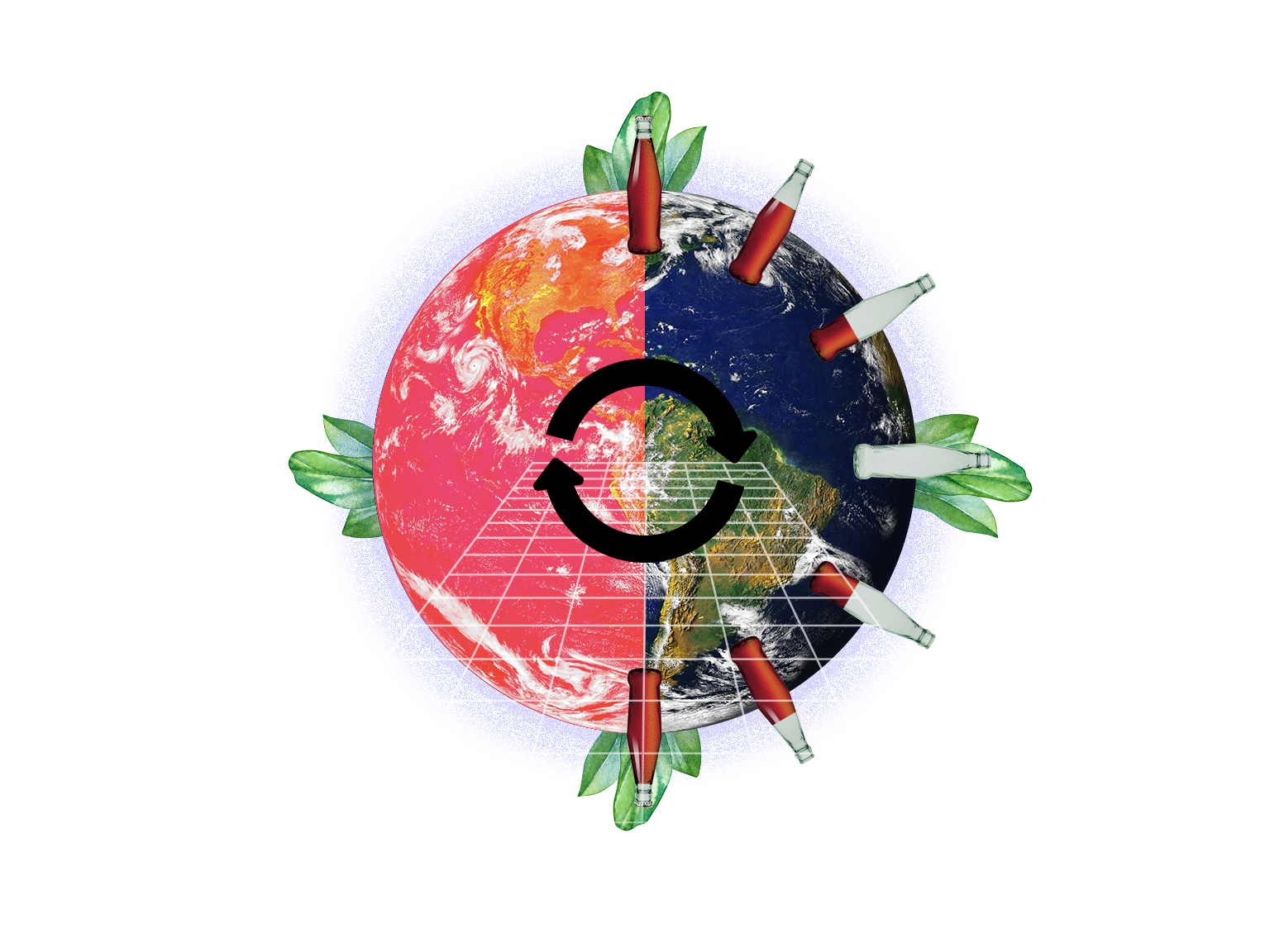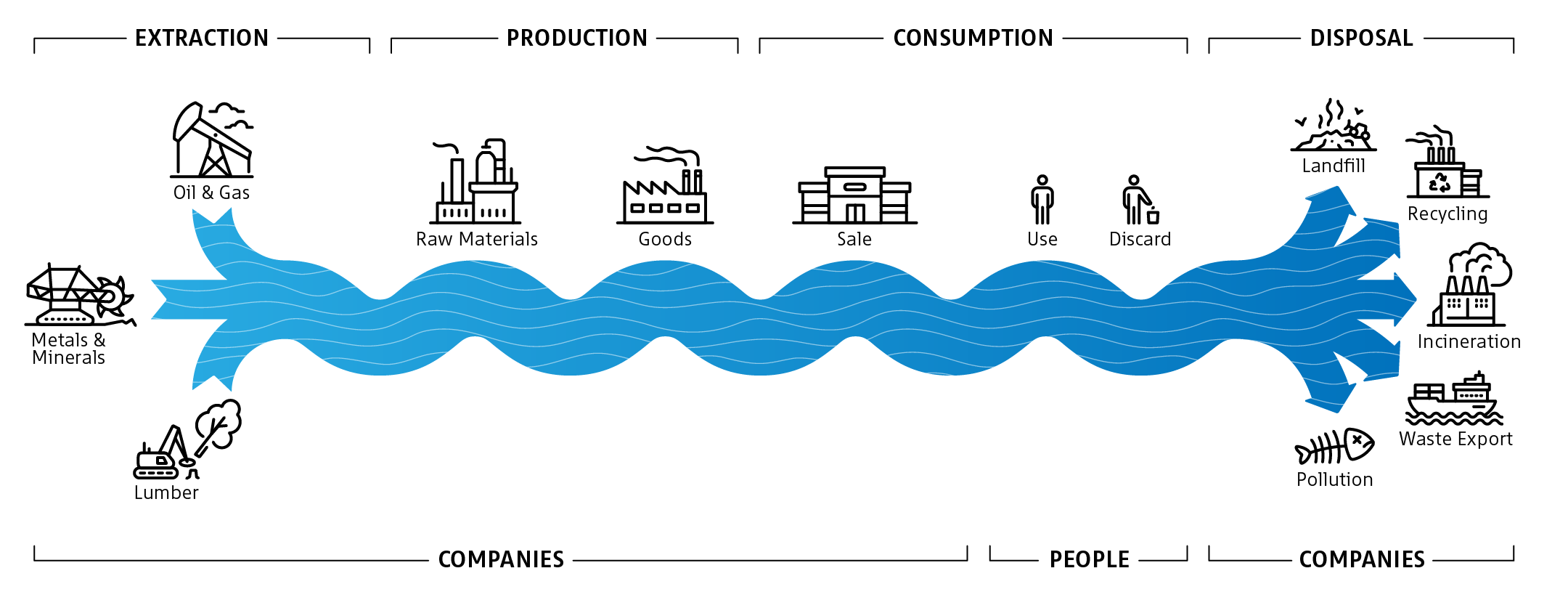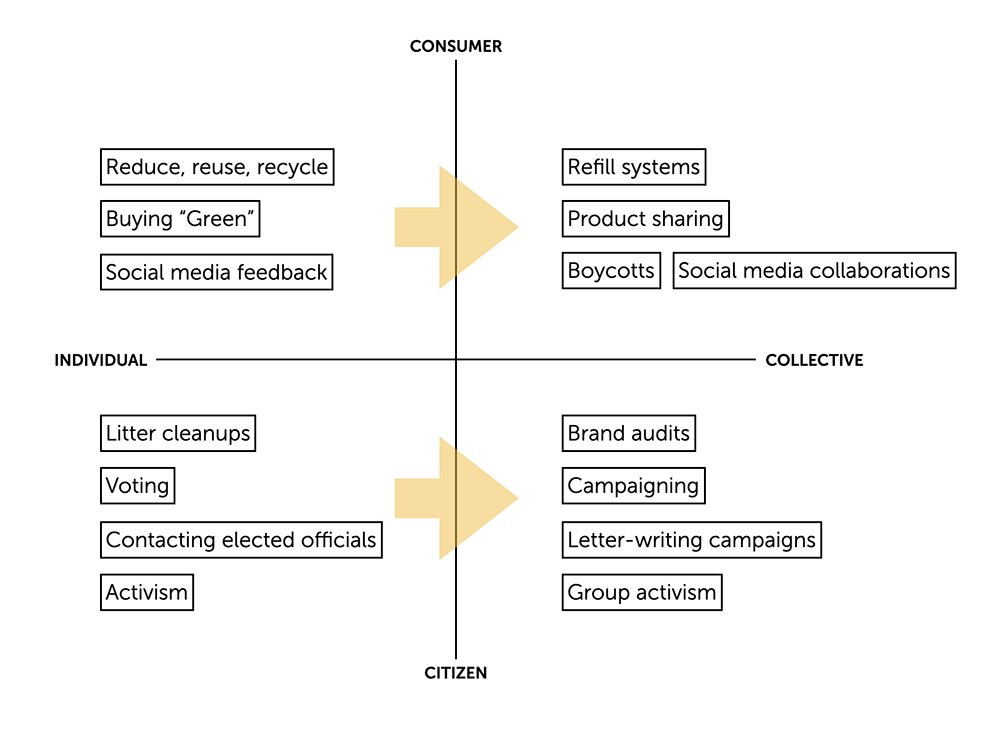Chapter 5
A path forward.

America needs a new approach to tackle waste and pollution problems.
In the previous chapters, we saw compelling evidence that recycling is not an effective solution to America’s waste and pollution problems. In chapter two, data from the US EPA shows that America generates more trash now than ever, both in terms of the total amount and the average amount generated per person per day, despite decades of recycling across the country. In chapter three, historical evidence about municipal recycling’s origins adds new context to the current popular belief that recycling provides meaningful environmental benefits to society. Knowing this, it’s easier to see how recycling benefits corporations more than the planet or people. And in chapter four, evidence about international trade practices and marine ecology reveal startling connections between the American recycling system and global plastic pollution.
The evidence shows that recycling and litter-cleanup events are not effective at reducing waste and preventing pollution – a new approach is needed.
Change starts with a systems-oriented approach.
The Recycling Distraction proposes a new path forward to attack waste and pollution at the source – the linear, take-make-waste economy. This approach is based on existing research and is heavily influenced by the circular economy framework (Ellen MacArthur Foundation). The strategy is based on the following three-pronged approach:
- Challenge the popular notion that waste and pollution are created by individuals; instead acknowledge the role corporations play in creating environmental problems.
- Make waste and pollution problems a political priority so lawmakers can hold corporations accountable for their fair share of environmental problems.
- Eliminate waste by design and understand where recycling is appropriate. The circular economy framework provides a guide for these actions.
Start by considering a holistic view of the linear economy.
Before acting on the strategy, it’s helpful to zoom out from the daily activities of buying, using, and disposing goods and view the linear economy from a bird’s-eye view. Let’s think of the linear economy as a river. Upstream, natural resources are extracted from the earth to make raw materials. Companies use those materials to make consumer goods. In center stream, the goods are sold, purchased, used, and thrown away. Downstream, the waste is managed in a variety of ways.

Remember that waste and pollution are created at all stages of the river, but not in equal amounts. Upstream and downstream actions have much greater impacts on the environment than center-stream actions.
Having this perspective enables us to understand where recycling is appropriate and where other actions, like incentivizing businesses to eliminate waste, are necessary. It also provides insight on how other economic actors, such as corporations, lawmakers, and NGOs, can have more impact on solving environmental problems than individual consumers.
Act as consumers and citizens.
As we saw in chapter three, environmental problems like litter and other forms of pollution are often framed in terms of individual responsibility and actions – a perspective that enables corporations to avoid scrutiny for their actions.
Let’s challenge traditional consumer-centric problem-solving approaches by expanding the realms where people can act. People can act as individuals and as groups, and as consumers and as citizens. The Recycling Distraction encourages people to take multiple forms of action to address environmental problems at the source.

Things you can do to challenge the wasteful, take-make-waste economy.
Stop referring to waste and pollution as "consumer" problems.
Companies create the conditions that lead to waste and pollution, not people. Companies decide if products are disposable or not, and if containers and packaging are made from biodegradable materials or not. Waste and pollution are business decisions, not consumer choices.
Transition to buying zero-waste products, if you can.
Refilling durable containers is better for the environment than recycling disposable ones. When your disposable products run out, see if there are refillable or biodegradable alternatives before buying a replacement. Many common household products, like cleaning supplies and health and beauty items are now sold in packaging-free and refillable formats.
Demand legislation to collect and track data on non-hazardous industrial waste.
Companies create 26 times more waste during the manufacturing process than people during consumption. Since Congress passed the Resource Conservation and Recovery Act (RCRA) of 1976, manufacturers have lobbied to keep data about non-hazardous industrial waste hidden from the public. Support efforts to collect data about manufacturers’ waste and how they dispose of it.
Support NGO efforts to enact policy change.
In recent years, the plastic pollution crisis has re-energized support for legislation to hold manufacturers accountable for their fair share of environmental problems. Organizations like Earth Day, the Sierra Club, and Story of Stuff are leading efforts to mobilize citizen support for policy action.
Ask your local elected representatives if they accept funding from the beverage, packaging, petro-chemical, or waste-management industries.
Corporations spend millions of dollars on lobbying efforts every year to influence public policies for their benefit. Ask your elected officials who funds their reelection campaigns, and if they work for corporations or citizens. If your representatives accept money from these groups, consider voting against them in the next election – and tell them your plans.
Turn a litter cleanup event into a brand audit.
Use Break Free From Plastic’s brand audit toolkit to turn your litter cleanup event into an act of resistance to the disposable economy. While picking up litter, also collect data about the items and their manufacturers. Call out the manufacturers on social media for creating the conditions for pollution.
Tour your local landfill and recycling facilities.
If your local landfill or materials processing facility offers tours, go see what happens to your household waste after it’s taken away. You might be surprised to see the journey your trash takes to reach its final destination. Facility tours often begin or end with educational presentations, so ask questions about where materials go, who pays for the service, and who benefits from the system.
Ask your local elected officials for an accounting of recycling's return on investment in your community.
Is recycling worth the effort, financial cost, and resources that your community puts into sustaining a recycling program? Does recycling reduce the waste your community sends to a landfill or incinerator? Ask your local elected officials for answers, because taxpayers often foot the bill for keeping recycling programs afloat when they aren’t profitable. Citizens are entitled to transparency about the effectiveness of their public services.
Support the Right to Repair movement
Many companies purposefully design their products to fail more quickly than necessary (called obsolescence), and restrict consumers’ ability to repair them. This boosts profits and creates a lot of waste. Support the Right-to-Repair movement to protect your ability to keep products lasting longer.
Email, tag, or call your favorite brands and ask them to switch to refillable containers.
Companies want to hear from their customers – feedback is valuable business information. Tell your favorite brands you love their products but hate the waste. Companies are more likely to change when customers demand it.
Thank your neighborhood trash and recycling collectors.
Collecting, transporting, and sorting waste is difficult, dangerous work. Thank the people who help keep your neighborhood clean.
Companies create pollution. Companies can stop it.
Remember, the next time you fret about recycling, or join a litter cleanup event in your community, consider this:
- Companies determine if products will be disposable or not.
- Companies choose which materials to use during manufacturing.
- Companies design products to be recyclable or not.
- Companies determine how many products will be made.
Companies decide if waste and pollution are inevitable or not.
Chapter 4: Recycling won’t prevent America from drowning in plastic waste.
